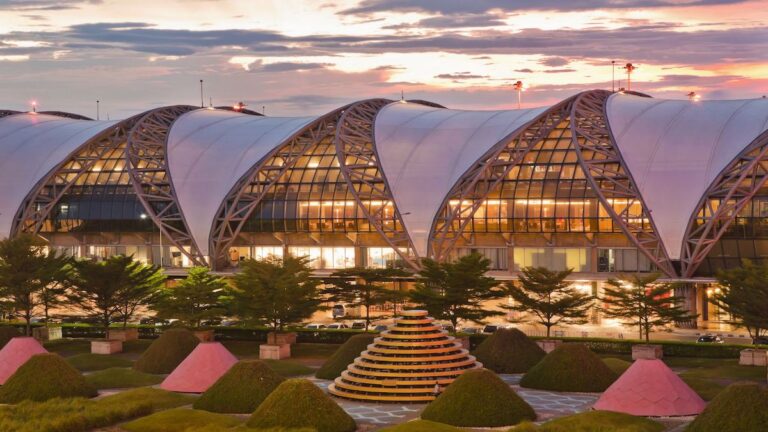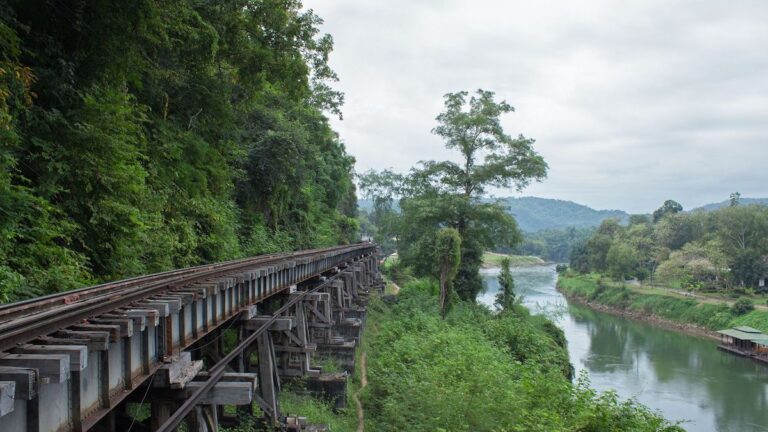Kanchanaburi Death Railway
Picture this: your life suddenly changes when an Imperial army invades. You’re rounded up and transported over 2000 km north to a steamy jungle, where you become forced labor, expected to work up to 18 hours a day. Screaming Japanese or Korean guards push you to work faster as you swing 10-pound hammers, tapping and drilling stubborn rock to create a near-impossible rail cutting.
But that’s not all. Imagine witnessing your fellow campmates being beaten to death by ruthless taskmasters, slowly starving, or succumbing to cholera without proper medical care. The horrors you must endure under these unbearable conditions are unimaginable.
History of Kanchanaburi Death Railway
It sounds like a nightmare, but for 60,000 WWII POWs from Britain, Australia, the Netherlands, and the USA it was a living hell that played itself out in the jungle of Thailand’s Kanchanaburi province and left 12,000 of them dead. These poor souls were joined by nearly 100,000 Asians who came here with the promise of work, only to perish as the Japanese Army attempted the near-impossible task of pushing through a 415 km rail link from Thailand to Burma. They said it would take six years, but under pressure to bring supplies to their forces in Rangoon, they achieved it in just 16 months, yet a tragic loss of life.
 Sixty years later Kanchanaburi is a peaceful, lush, and popular destination for both foreigners and locals, most of who were born after the Great War and little appreciate the sacrifices and loss that this area has come to symbolize on most tourist maps. The men may not have died in combat or specifically defending Thailand, but their two-year drama has left a legacy that has turned the area they must have despised so much into a lucrative tourism magnet for several generations since.
Sixty years later Kanchanaburi is a peaceful, lush, and popular destination for both foreigners and locals, most of who were born after the Great War and little appreciate the sacrifices and loss that this area has come to symbolize on most tourist maps. The men may not have died in combat or specifically defending Thailand, but their two-year drama has left a legacy that has turned the area they must have despised so much into a lucrative tourism magnet for several generations since.
Located a mere two-hour drive West of Bangkok, Kanchanaburi offers so much more beyond somber memorials and cemeteries. Visit the winding river, where weekend nightlife takes over on disco barges. Take in the natural beauty of national parks with trekking opportunities and stunning waterfalls. Don’t miss the chance to explore caves or even snap a photo with tamed tigers under a monk’s care. And let’s not forget the historic tale of the Kanchanaburi death railway and bridge, memorialized in the classic film, The Bridge on the River Kwai. Experience it all in Kanchanaburi – the perfect blend of adventure and history.
In 1942 construction commenced on a rail plan that had been surveyed previously by the British but abandoned as logistically too challenging. Indeed, to the West of the town lies a low but formidable range of hills that has, for centuries, drawn the border between Siam and Burma. With the Japanese Army occupying Thailand and Burma, their next move was to attack British India, but they found their supply route in the Bay of Bengal cut off, so work began on the rail link in earnest.
As the pressure mounted on them from the American advances in the Pacific, the urgency to finish this route intensified. And as it did life became hell for the prisoners of war and locals who gave their lives to achieve this remarkable feat. In late 1943, the two sections, one started in Thanbyuzayat in Burma and another in Nong Pladuk in Thailand, met near the Three Pagodas Pass. It lasted just 20 months before the bridge over the river Kwai was bombed in the closing stages of the War and the full section of this narrow gauge railway was never used again.
Death Railway Museum
Today there are several museums in or near Kanchanaburi that tell the horrific story of the Kanchanaburi Death Railway. Parts of the rail do still exist, and you can walk lengths of it, while parts are now submerged by the Khao Laem dam. But the most chilling reminder of the era is the handful of cemeteries that dot the area.
There is one right in the middle of the tourist area of the town, containing several thousand neatly arranged plaques to British and Dutch soldiers who perished from overwork, injury, and disease. The Allied War Cemetery is the most visited and accessible, and opposite it is the excellent Thailand Burma Railway Center, which tells the full gruesome story in excellent detail.
A few kilometers outside of town is the more peaceful Chung Kai War Cemetery. Another museum, the JEATH museum, is located on the riverside nearer the new town but is somewhat dated and doesn’t compete with the other big-budget foreign museums. But perhaps the most visited attraction in Kanchanaburi is the famous Bridge over the River Kwai, which was the centerpiece of the Hollywood movie of the same name.
This distinctive steel bridge was one of two that were used, including a wooden temporary bridge further north, and was eventually bombed by an allied air attack in 1945. After the war it was rebuilt and trains, mainly full of tourists, run across the bridge and as far as Nam Tok, with the highlight being a precarious section over an original wooden cliffside support alongside the river at Kra Sae.
If you’ve come specifically to trace this sorry part of recent Southeast Asian history, you should make a trip to Hellfire Pass, which holds some of the worse memories. This particular cutting is the deepest and most impressive of the many points along the line that kept dozens of camps occupied.
In 1998 the Thai–Australian Chamber of Commerce opened an excellent memorial museum here for the benefit of relatives and tourists. With an exhaustive headphone commentary, visitors are taken on a dramatic tour of the life and times of those who suffered at the Kanchanaburi death railway.
The cutting itself is more than 50 meters long and 20 meters deep, all cut with minimal machinery. The death toll here was particularly cruel –nearly 70 percent of the labor force perished –and a ceremony is held every year on ANZAC day. Among other things, you learn of the conditions they lived in, their relationship with their slave drivers, and the awful diseases from the constant wet weather.
It’s difficult to visit Kanchanaburi and not come away with a somber sense of respect and sorrow for the cruelty that took place here for 16 awful months in 1942 and 1943.
The stories that are told are heartbreaking, the depth of human lack of compassion astonishing under the theatre of war, and the atmosphere humbling, as we consider the peaceful times we enjoy with our backpacks or comfy boutique hotels. Kanchanaburi has a remarkable beauty in its lush vegetation, multi–layered waterfalls, horizons full of mountains, and a pretty river. But for some, they simply couldn’t appreciate it through the hellish times experienced here 60 years earlier.
By Andrew Bond



